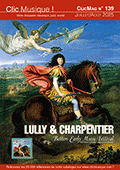 De ses origines populaires le violon tient-il la capacité qu’il offre à ses interprètes de franchir les frontières entre différents genres et styles de musique ? À l’instar de David Bongartz (Garrett), Nigel Kennedy, Nemanja Radulovic, Pavel Šporcl, le musicien au violon bleu, n’hésite pas à délaisser l’univers classique pour réunir dans son Gipsy Way Ensemble ses racines tchèques, ses accointances slovaques et l’univers tzigane. Dans le présent enregistrement il réunit huit pièces dévolues aux aspects variés du violon solo. Le célèbre Caprice en la mineur (n° 24) de Paganini bénéficie en ouverture d’une interprétation aussi diaboliquement maîtrisée que puissamment expressive. Lui succèdent des œuvres de Josef Slavík (1806-1833), Schnittke (1934-1998), Ernst (1814-1865), Kreisler (1875-1962), et Milstein (1903-1992), qui ont toutes en commun de sublimer l’art du violon tel que Paganini l’avait conçu et pratiqué. Écoutez par exemple The Last Rose of Summer dans l’adaptation de Heinrich Wilhelm Ernst, infiniment plus difficile que les Caprices de Paganini, superbement interprétée avec panache et sensibilité par Pavel Šporcl ; ou l’hommage A Paganini de Schnittke, qui, en 12’34, résume musicalement la vie du violoniste ayant vendu son âme au Diable jusqu’à ce que la mort l’emporte dans une résolution finale dramatiquement discordante. Pavel Šporcl ajoute à ces pièces des Variations de son cru sur l’hymne national tchèque et la cadence richement mélodique que Jan Kubelik (1880-1940) écrivit pour le 1er mouvement du 1er Concerto de Paganini. Magnifique. (Jacques-Philippe Saint-Gerand)  Pavel Šporcl explains: “Paganini was the best – a magician of the violin. Violin technique and the way we play today are largely due to Paganini.” Paganini’s influence continues with Josef Slavík’s Caprice, in what is a world premiere recording. ??n his day, the Bohemian violinist (1806–1833) was often compared to Paganini. The only serious contender to the virtuoso crown in Paganini’s lifetime was Heinrich Ernst (1814–1865), with his variations on Last Rose of Summer. Nathan Milstein (1904-1992) was one of the greatest violinists of the 20th century. As a tribute to Paganini he wrote his Paganiniana. These variations include the theme of the 24th Caprice, and from the other caprices, too. Šporcl plays his own variations on ‘Where is my homeland?’, a theme composed in 1834, which became the Czech national anthem in 1918. Alfred Schnittke (1934–1998) is the most modern composer included, with his tribute, A Paganini. The only non-violinist here, he wrote many great works for violin. Of all the violinists here, Fritz Kreisler (1875–1962) was the least virtuosic. His Recitative and Scherzo, which he dedicated to violinist Eugène Ysaÿe, makes a lovely encore in the Romantic style. Finally, by way of bonus, Šporcl plays the cadenza for Paganini’s Violin Concerto in D major, written by Jan Kubelík (1880–1940). Pavel Šporcl and his famous blue violin, which was created by leading contemporary instrument maker Jan Špidlen, are celebrated around the world. He is considered in the ‘royal line’ of Czech violinist.
 |
